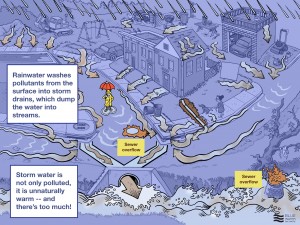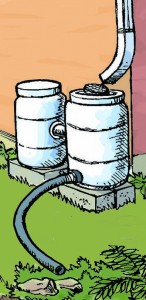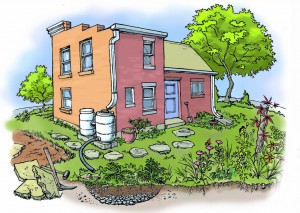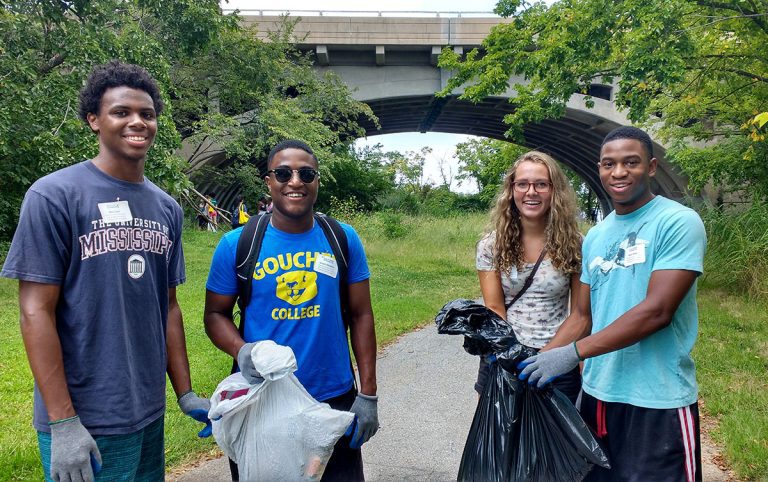Water Pollution Connections: Part 2 of 2
Last week, in the first part of this two part series on water pollution, I explored the connection between energy, water, and pollution.
This week my focus is on the home: how water and pollution are connected to where we rest our heads. You’ve likely heard the terms stormwater and urban runoff (if you’d like more information about these issues, I highly recommend you check out the US EPA’s ‘After the Storm’), but many people are shocked at how directly our man-made environment contributes to water pollution.

And once you’ve made the mental connection between water quality and impervious surfaces such as rooftops and roadways, it’s nearly impossible not to shudder each time it rains. You’ll find yourself worried about the consequences of all the water that washes over these surfaces, picking up pollutants along the way. Ultimately, most of it will end up flowing through pipes straight to our streams without being treated or slowed down. Visit your local stream next time there is a big rain. The horror!
While there is a lot of bad news, there is also good news. First, a little more of the bad news: each home in Blue Water Baltimore’s watersheds produces anywhere from 30,000 to over 100,000 gallons of runoff annually. Where your runoff goes varies depending on the characteristics of your home. Now for some of the good news: regardless of where you live or what type of home you live in, there are things you can do to reduce your home’s impact on streams, and Blue Water Baltimore is dedicated to making these actions attainable and affordable.
Let’s begin with downspouts, you know, those metal tubes connected to your gutters that you only take notice of when there is a problem? Many downspouts are directed into what’s called a standpipe. This pipe is connected to another pipe that takes water away from the house. While this is great for delivering water away from your foundation, if the pipe goes all the way to the street, it is very bad for streams. Not to mention that if this pipe is made from terracotta, it could be cracked and if it runs along the side of your house, a broken pipe could actually be the cause of basement flooding.

One downspout compromise is to ‘disconnect’ it. Essentially this entails capping the standpipe and directing the downspout to the yard where your roof runoff will seep into the ground. This is a great solution if you have a grassy yard that slopes away from your house, but not very steeply. If the conditions are right, disconnecting your downspout can reduce the runoff from your roof by as much as 100 percent during a one inch storm. To make it easier for you, Blue Water Baltimore will come out to your home and not only let you know if disconnecting is a good idea, but we will do the work for you free of charge.
If you can’t disconnect a particular downspout, a downspout is already disconnected, or you would like to have an alternative outdoor water source, rain barrels may be the solution for you. We offer a $25 incentive off the cost of a rain barrel–no matter where it is purchased. Typical rain barrels have a capacity of 50 to 100 gallons and they will capture the runoff from a small storm, but will be overwhelmed in larger storms. Not to worry, when Blue Water Baltimore comes to install your rain barrel for you free of charge, we will be sure to address this issue.
If you do a lot of outdoor watering, or if you have too large a roof to safely disconnect to your yard, rain water harvesting may be the right solution for you. Rain water harvesting is essentially capturing water from the roof, like in rain barrels, but at a larger scale. Through the Water Audit Program, you can receive an incentive of $1/gallon on systems with tanks with a capacity of 200 gallons or more.
If you have a small yard or you just want to be as runoff-conscientious as possible, a rain garden may be in your future. Rain gardens are landscapes that are recessed three to six inches to capture the runoff from larger storms and give it time to soak into the ground. We offer incentives for rain gardens, matching the dollar amount you spend, up to $500.

But wait, that’s not all. Also available are incentives for planting trees on your property, replacing lawn and bare soil with native plants, and eliminating hard surfaces such as sidewalks and driveways. Find out all the details on the Water Audit Program web page. From here you can sign up for the program and a Blue Water Baltimore staff person will be in touch to get you started on your journey of reducing runoff.
Do you have an idea for a project that is good for streams but does not currently qualify for an incentive? In the coming years, Blue Water Baltimore is looking to expand this program and we want to hear from you. Are there types of projects would you like to do at your home but can’t afford it unless there is an incentive? How much are you willing to pay? Would you be willing to participate in a workshop to develop new incentives? Email me with your ideas. I look forward to hearing from you.

